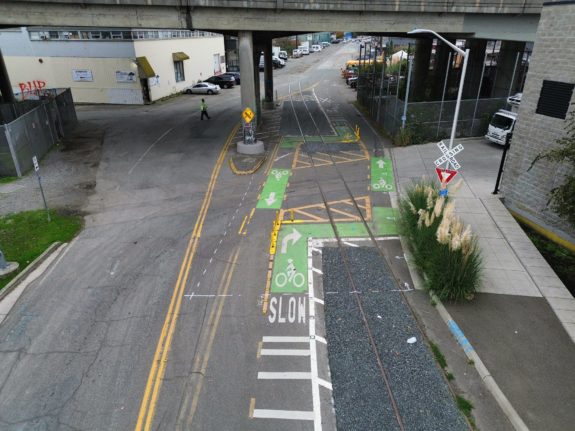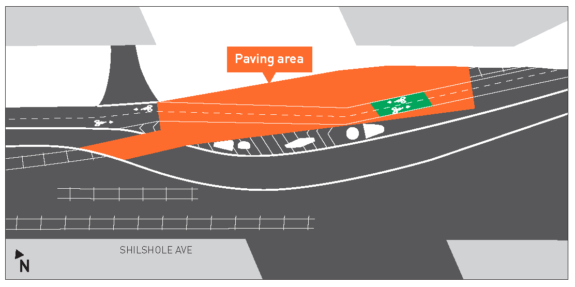
Within hours after the City Council approved a deal with the railroad now formerly known as the Ballard Terminal Railroad Tuesday, SDOT crews had already marked out the area under the Ballard Bridge where they plan to pave over both the railroad tracks and gravel pits in order to create a safe bicycle pathway.
Work is set to begin “hopefully this week,” according to Councilmember Dan Strauss who facilitated this agreement process through the Council. Strauss is not the Transportation Committee Chair, but the track crossing is in his district.
The fix should finally end, or at least substantially reduce, the number of people who will crash while biking through this particular area of the Ballard Missing Link of the Burke-Gilman Trail. Countless people have been injured crossing these tracks, which cut a shallow angle across the roadway that makes it difficult and awkward for riders to cross them at a safer 90-degree angle. Additionally, the gap between the roadway surface and the tracks is uneven and irregular. These factors combine to create a situation where people’s tires can slip into the gap, which then “grabs” their wheels and sends riders crashing with little to no warning. Others have crashed because the rails can get very slippery when wet and the sharp turning maneuvers required to cross the tracks mean people’s tires may still be in contact with the rails when they lean into a turn.

Crashing on the tracks here has long been a sad rite of passage for people biking in Seattle, who may not have heard about the danger of the Missing Link before riding through. But even seasoned riders have crashed here because all it takes is a slight misjudgment, such as straightening out too soon or turning before your wheels are clear of the wet tracks, for something to go wrong.
The railroad agreed to allow the paving work because they needed city approval in order to transfer the rail line franchise agreement from the Ballard Terminal Railroad to the Meeker Southern Railroad, a “related entity” of the Ballard Terminal Railroad. Paul Nerdrum from Salmon Bay Sand and Gravel signed the agreement (PDF) twice, once as the Managing Member of BTR and once as Managing Member of MSR. Director Greg Spotts signed on behalf of SDOT. Salmon Bay Sand and Gravel and the Ballard Terminal Railroad have fought for decades against the city’s plans to complete the Burke-Gilman Trail through Ballard.
The agreement does not alter any of the conditions of the existing 30-year franchise agreement, which began in 1997 and is still set to expire September 29, 2027. So the railroad is not abandoning the line, though it will effectively be cut in two once the pavement goes in. If the railroad wishes to uncover the tracks and restart using them, they will need to obtain insurance to do so and will need to “provide notice to the City sufficient for the City to reroute the existing multi-use path that crosses the rail line to a different location before the asphalt is removed.” Given the multiple ongoing legal claims filed against the city and Ballard Terminal Railroad over injuries caused by the dangerous track condition, it may be difficult or expensive to acquire the needed insurance.
This is not the end of the Missing Link saga, though it is a promising development. The completed design for the trail, which is still held up in endless litigation, would bypass this crossing area entirely. But as we noted in our previous post, the obvious best route for the trail has always been on top of the rail line like most of the rest of the trail. However, since federal laws are understandably protective of rail corridors, building the trail on the railbed has not been an option so long as a railroad has an active franchise. Once the pavement is in place, there will seemingly be no use for the section of tracks south of the Ballard Bridge, which will no longer have a connection to the main rail network.
It is also not entirely clear why the railroad owners wanted so badly to transfer the franchise rights from BTR to MSR that they would agree to this deal. On paper, it appears that the city gave up almost nothing to get this win, which is perhaps an uneasy feeling for trail advocates who are still waiting for the other shoe to drop. But the agreement does give trail opponents a potential lever going forward: The threat of restarting operations and removing the pavement.
The Washington Bike Law claims and lawsuits on behalf of injured riders (and the unfortunate fact there are many more potential claimants in our city who have yet to file them) may prove to be a vital piece to holding this delicate agreement together because those claims likely dictate the insurance problem for the railroad. Every month for many years, an average of two people have required emergency medical attention following a crash while biking on the Missing Link, and it has been that way for decades. Many more people have been injured but did not make a 911 call (transported themselves to the hospital or made it home only to realize the extent of the injuries later). This means there will always be the potential for fresh claims, a fact any potential insurer would hopefully be reluctant to risk. (Full Disclosure: Washington Bike Law advertises on Seattle Bike Blog, though their sponsorship does not influence our reporting).
The best outcome for nearly everyone is for the railroad to abandon this line. There is no business need for it, and it has been that way for a long time. This is why BNSF abandoned it in 1997. Building the trail along the tracks would dramatically simplify the trail design, reducing the impact on loading docks, car parking and traffic flow while also removing a hazard. This agreement does not accomplish that, but I guess we’ll see how long the folks behind the Meeker Southern Railroad will keep spending money to maintain this farce.







Comments
4 responses to “Council approves deal to pave over the Missing Link tracks under the Ballard Bridge”
Promising news, but I’ll see it when I believe it. As NOFX says, dinosaurs must die.
And on September 29, 2027 the franchise agreement ends. Doesn’t this mean that the railway goes back to the city? And we build a bike trail on top of the rail line?
Well, I am not sure about that. I don’t have a full understanding of rail laws, but I think if a railroad company seeks a franchise, the city may be essentially forced to grant it. I’m sure there are stipulations and loopholes and all that, though, so take this with a grain of salt.
They were out paving the space today when I rode by – bikes were detoured a block North. Did not see the locomotive in the barn.